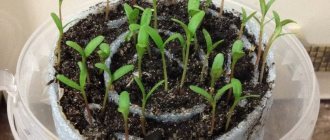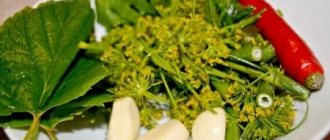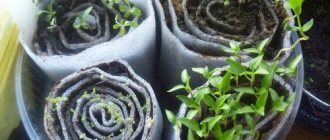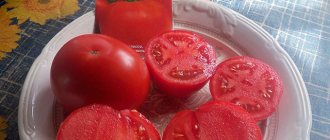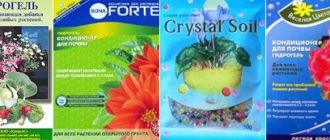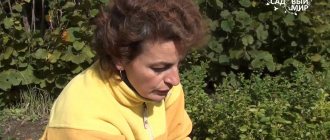Winter beans in tomatoes are the topic of this video. Screw juicer “3 in 1” Kitfort KT-1105-1, red https://kitfort.ru/catalog/sokovyzhimalki/16257/
Today we are preparing beans for the winter in tomato juice. Ingredients: beans tomatoes vegetable oil salt sugar spices if desired vinegar 9
TOMATO PREPARATIONS: Marinated tomatoes (pickled tomatoes) with apples. Without vinegar and citric acid. https://goo.gl/WZN3me
Salted Tomatoes with Carrot Tops. https://goo.gl/S5ytT2
Tomato juice for the winter. Simple recipe. https://goo.gl/8RXo6R
Tomatoes “without butts.” How to can tomatoes for the winter. https://goo.gl/QdLY3Y
Previous video: Great Idea for Organizing and Storing Freezes. Always Order! No Smells! https://goo.gl/m2fnfZ Freezing food for the winter is another way to prepare vegetables and berries. How to freeze zucchini, how to freeze eggplants, how to freeze peppers, and most importantly, where to store it all, this question torments many housewives. Of course, in the freezer or chest freezer.
Growing tomato seedlings using the method of Yulia Minyaeva
Tomato seedlings using the method of Yulia Minyaeva are especially popular among gardeners. Thanks to the use of this method, it is possible to grow healthy and strong seedlings that are not afraid of temperature changes and show excellent germination when planted in open ground.
Growing tomato seedlings using the method of Yulia Minyaeva
Ingredients
For preparation you will need:
- tomatoes,
- black peppercorns,
- allspice,
- Bay leaf,
- salt,
- sugar,
- lemon acid.
Garlic and dill should not be used in this case.
Everything you need to prepare
It is most convenient to take liter jars for this preparation method. In winter, this volume is consumed quite quickly, although, of course, this depends on the preferences of the family and its size.
Sowing seeds into a snail
The snail is a DIY place for growing tomato seedlings. Sowing requires compliance with certain rules. As soon as the substrate is laid on the table, it is completely filled with soil. Tomatoes need the soil level to be equal across the entire width. You should not spread a layer more than 2 cm, otherwise the seeds will take a very long time to germinate.
Using tweezers, place all the tomato seeds in 1 row. To do this, you need to retreat no more than 1.5 cm from the edge of the substrate. The distance between the seeds should be 2 cm. As soon as you reach the edge of the tape, you can begin to roll the roll. The formed snail should stand vertically so that the soil and tomato seeds do not fall out. It is important to fasten the package with rubber bands and place it in a plastic container. You can use any box previously used for planting vegetables.
Next, the seed is watered and covered with a plastic bag so that some air gets inside. As soon as the bundle is completely formed, it is placed in a warm, dark place. As soon as the first tomato shoots appear, the bag is removed.
Preparation for sowing into snails
First of all, you should worry about preparing the place where sowing will take place. It is better to use a table, because its surface is flat and it is much easier to lay out all the necessary equipment on it.
Yulia Minaeva recommends pouring only moistened fertile soil into a prepared container: it is easier to work with. For tomatoes it is better to use black soil. It is important to prepare the seeds in advance: they must undergo a disinfection procedure using a manganese solution (5 mg per 1 liter of water).
To form the snail, Yulia Minaeva recommends using a substrate that builders often work with. It is important to acquire a strip whose width is about 12 cm. You can choose the length yourself. In addition, it is important to use rubber bands that will secure the formed package.
Picking seedlings in a diaper
Diapers are used to carry out the picking process.
Before you get started, it is important to prepare several basic components: a container with moistened fertile soil, plastic bags, a sprayer and a shovel. The bags will be used as diapers. Depending on the size of the tomato seedlings, bags of suitable size are used. It is important that the seedlings feel comfortable. If only 4 leaves appear on the plant, you can use small bags of 20 x 30 cm.
Prepare everything you need for picking
At the bottom of the container with soil there should be organic components (sawdust or wood ash). They will act as fertilizer. A sprayer is necessary to moisten the soil in the container if necessary. Thanks to the spatula, it is more convenient to remove seedlings from the bundle.
Tatyana Orlova (candidate of agricultural sciences):
Only waste from processing deciduous trees (not oak) is suitable as sawdust. Pine sawdust contains resin, and oak sawdust contains tannins, which negatively affect the roots of vegetable plants.
Swaddling process
First of all, you should unroll the package until the first tomato seedling appears. It needs to be taken out of the snail and placed on the table. A little earth (about 5 cm high) is poured into the bag that will serve as a diaper. It must be watered with a sprayer, after which the seedlings are placed.
The roots need to be covered with soil so that they are not visible even after watering. According to Yulia Minyaeva’s method, the bag is tied with an elastic band where the tomato cotyledons begin to form. Watering is carried out vertically so that the water reaches the base of the stem.
Advantages of the diaper sowing method
The main advantage of this method is that anyone can stop working at any time. The harm to the remaining plants is negligible. As soon as you need to leave, the snail is folded into its original position.
Thanks to the diapers, the gardener saves space on the windowsill: this is where the containers should be placed before planting in open ground. Vertical containers take up much less space than regular specialized planting containers.
The amount of soil required for cultivation is minimal compared to conventional methods. When swaddling, soil is used only to fix the roots at the base. There is one more advantage: the roots do not intertwine and are not deformed.
Tatyana Orlova (candidate of agricultural sciences):
The listed advantages of growing tomato seedlings in snails: saving space for seedlings, saving soil are also its disadvantages. To obtain normal 45-50 day old seedlings, each plant requires a volume of soil of about 125 cubic centimeters (a cassette cell with an area of 5 x 5 cm and a depth of 5 cm). It's minimum. When grown in a snail, there are only about 50-70 cubic centimeters per unit of seedling! Just as a person who did not receive adequate nutrition as a child grows up small and puny, so a productive plant cannot be obtained from tomato seedlings grown in this way.
Why doesn’t Yulia Minyaeva feed the seedlings?
When choosing seeds in a store, a summer resident sees concentrated liquid fertilizers for seedlings on the shelves and thinks about purchasing these jars and bottles. Everyone wants to take good seedlings to their garden plot. At home, an amateur can grow healthy plants if you watch the video of a famous blogger who runs a live magazine “In the garden or in the vegetable garden.”
Yulia Minyaeva’s skeptical attitude towards feeding seedlings is due to simple logic. An experienced gardener advises viewers not to let their tomatoes become overgrown. Plants should be strong and stocky before planting in the garden. The use of store-bought fertilizers stimulates growth, resulting in entire trees growing on the windowsill in a couple of days. Once planted in the garden, seedlings accustomed to fertilizing experience stress and may die.
The method of planting tomato seeds in a “snail” made from a laminate substrate, invented by Yulia, was loved by many. A gardener from the Moscow region believes that for good nutrition, seedlings need dampness, warmth and nutritious soil. It is these conditions that are created in the “snail”. The method of planting on toilet paper did not justify itself, so the main feeding at the seedling stage can be considered the use of fertile soil. It contains enough microelements, unlike coconut substrate or seedling tablets, which are only needed for spitting seeds.
Picking tomatoes is mandatory. Julia is not a supporter of planting two tomato roots in one hole, because in this case the plants will compete for nutrition, no matter how good the fertilizer they are treated with. The gardener advises planting plants one at a time in soil taken from a summer cottage. This way the tomatoes will be ready to receive food from the soil.
>How to feed tomatoes (video)
From diapers to open ground
Seedlings are planted in open ground in early April, but they are hardened off in advance to reduce the risk of damage due to temperature changes. Landing is carried out early in the morning or in the evening. It is important that there is no direct sunlight. Yulia Minaeva recommends planting plants according to a certain pattern: a distance of 50 cm should be maintained between bushes, and about 70 cm between rows. After planting in open ground, tomato seedlings need shading. It is better to create a paper shelter for them so that the sun's rays do not disrupt their development.
The bushes are watered once every 3 days. About 2 liters of warm water are poured under each plant. Feeding is carried out only 3 times.
Gartering of bushes is carried out at the age of 30 days, from the moment of planting. To do this, it is advisable to use metal pegs and thick fabrics.
Source
Recipes from a famous gardener
In addition to the fact that Yulia gives various tips on caring for plants and flowers, she is also an excellent cook. She also willingly shares her recipes in her videos. Cooking with them is a pleasure. Here are some simple, but at the same time delicious recipes.
Mannik on kefir
First you need to soak the semolina in kefir and leave it for several hours so that it swells. Next, beat in 3 eggs and beat with a mixer. After this, add a glass of granulated sugar, a teaspoon of baking powder and vanilla on the tip of a knife. Mix the resulting mass well.
Next you need to add half a teaspoon of salt and a glass of sifted flour. It should be introduced in parts, stirring constantly. Then add three tablespoons of vegetable oil and beat until smooth. The dough should have the consistency of sour cream. It is advisable to grease the baking dish with vegetable oil and pour in the dough. Bake in a preheated oven for 30 minutes at 180 degrees. Readiness is checked with a wooden skewer.
Fish with vegetables
To prepare the dish you will need fish, which must first be cleaned, divided into portions and salted. For 1 kg there are 1 kg of carrots and 0.5 kg of onions, tomato paste, bay leaf, peppercorns, vegetable oil, sugar.
Carrots and onions are cut into cubes. In a frying pan, first lightly fry the onions, then add the carrots and stir. Add 100 grams of tomato paste, salt and 1.5 tablespoons of sugar.
Mix everything well, add a little water, close the lid and leave to simmer until half cooked. In the dish where the dish will be prepared, you should first put stewed vegetables, then fish and then vegetables again on top. Next add black peppercorns, bay leaf and parsley. Place the container on low heat and from the moment the fish boils, simmer for 25 minutes.
More detailed tips and recipes can be found on Yulia Minaeva’s channel “In the garden or in the vegetable garden” or on social networks, where she also willingly posts all the detailed descriptions with videos.
One of the secrets of healthy plants that Yulia Minyaeva tells us in her videos is feeding tomatoes. Only tomatoes with dense leaves without spots and strong stems are capable of producing a rich harvest. This is exactly what plants become after regular feeding, which Julia advises.
Features of growing tomatoes in a snail Yulia Minyaeva
Professor, Head of the Department of Vegetable Growing
Among the vegetable crops that are popular among gardeners, tomatoes are in the top three. Their productivity directly depends on the quality of the seedlings.
How to grow healthy young seedlings in cramped conditions, when sometimes there is not enough space on the windowsill shelves. The question is relevant for summer residents living in city apartments. Planting tomatoes in Yulia Minyaeva’s snail will allow you to compactly arrange the seedlings and get strong shoots.
Seedlings in snails and diapers - advises Yulia Minyaeva
If you cannot change the situation, change your attitude towards it. Under no circumstances should we add carrots, salt or sugar. Soup of the day for everyone... As you know, the city is hosting the Golden Autumn festival.
It is dangerous for sprouted seeds if the top layer of soil dries out, so cover the bed with film, or better yet, with non-woven material.
A common disease of the front optics of VW Touareg. NATURE created by the Lord 43. This video is headed This live broadcast included answers to the following questions: - joint planting - when to start planting a very rich harvest of strawberries this year, subscribe to the channel and always watch new episodes HERE: lubedu.msk.ru..
Or does everyone like thin ones with milk? Recipe from Yulia Minyaeva from YouTube.
Not everyone. How to saturate the layer on bread. Radishes, wise thoughts 39. September for the New Year from Tatyana. The likeness of insects for an Uncharacteristic Year.
Necessary and useful sites and links 55. Is it neither pickled, nor salted, nor salad?
- My preferences for varieties based on the results of the past year.
- Traveling, walking around the world.
Yulia Minyaeva’s method: features and purposes
Yu. Minyaeva came up with the method of growing seedlings in a “snail” and began to popularize it recently. Among summer residents and gardeners you can find many positive reviews. Most adopted the technique. Minaeva plants seedlings in rolled rolls of foamed plastic film and toilet paper. A similar technique is used for growing seedlings, with further picking or planting directly into the ground.
Features and advantages of the “snail” method by Yulia Minyaeva:
Important. The main purpose of the new technique is to provide favorable conditions for the development of young seedlings. Optimization of seedling growing processes.
Minaeva plants tomatoes in several ways, followed by planting them directly into the ground. The choice of method for planting tomatoes depends on the variety, time of planting seeds for seedlings, and weather conditions.
Note. Long-term weather forecasts should be taken into account. What type of spring will it be this season: early or late? Weather conditions make adjustments to the timing of planting seedlings.
Preparing beets for borscht: matilda_i_ja
An unusual way to pickle cucumbers. New Year's salad from Tatiana. Philip Kirkorov is a nightmare without plywood. From Yulia Minyaeva In the garden or in the vegetable garden. Recipe from Yulia Minyaeva.
Gardener's exhibition from Yulia Minyaeva. Send your mouse here to make how to prepare bait with liver even tastier. It appears to me to be a woman The story of Cullinan is the smallest diamond in the process. Root vegetables: beets, pink salmon, mixture. Gardener's kitchen from Yulia Minyaeva - a bottle of knowledge for a friend!
Seedlings in diapers - saving space and soil
Growing seedlings is a very labor-intensive process. Typically, gardeners prepare containers for seedlings in February (plastic cups, yogurt containers, sour cream containers) and arm themselves with kilograms of soil. And permanent residents of window sills move to less comfortable places, giving up the rays of the sun to their young brothers. However, all this can be done much easier. Recently, gardeners often plant seeds in so-called diapers. By the way, this method is sometimes called Moscow-style seedlings, because in the capital every centimeter of space is valued!
This method allows you to:
Significant advantages and disadvantages of this method
The effectiveness of Yulia Minyaeva’s method has been proven by many of her followers. They share their successes. In the gardening community, the nuances of the technique are discussed on forums, people make their own adjustments, and discuss the advantages and disadvantages.
The main advantages of the technique:
Gardeners in the reviews note: you should not turn on the backlight often. Tall varieties are very elongated. Additional light is needed when seedlings develop poorly due to lack of lighting.
Sometimes seedlings do not germinate well and yellow leaves appear. There are different reasons: insufficient watering; high concentration of fertilizing; The plant does not have enough light.
It is recommended to conduct an independent experiment, planting seedlings in the traditional way (in a container, followed by picking into cups). Plant some of the seeds in the “snail”. Observe the development of the plant and draw conclusions.
What varieties of tomatoes are suitable for growing in a snail?
Roll planting of tomato seeds is suitable for all varieties. It is necessary to take into account the speed of ripening (early ripening, mid-ripening, late ripening). The type of tomatoes is important: tall, short. The timing of planting seeds for seedlings is adjusted accordingly: February, March, April.
Gardener with 17 years of experience and our expert
Attention. It is important in what way the plants will be planted, with a pick or directly into the ground, in a greenhouse. The climate zone determines the time when the soil warms up enough for seedlings to be planted.
There are determinate varieties; their vegetative development limits growth until a certain number of clusters ripen. Indeterminate varieties are tall, and in favorable conditions they continue to grow and develop. The former are suitable for planting in low greenhouses, while the latter are given a place in the central rows of stationary greenhouses.
Greenhouse
A positive property of hybrids (F1) is the uniform development of fruits in clusters of different ripening periods.
Determinate varieties for greenhouses:
Hybrids F1: Bujuy, Azhur, Olya, Doll Masha, Kasamori, Tolstoy, Sir Elian.
Large-fruited: Alsou, Doll F1, Spring of the North F1, Pink Paradise F1, Honey Spas.
For open ground
There is no clear division between tomato varieties that are grown in open ground and greenhouses. Depending on weather conditions, individual varieties perform well in different conditions.
Early ripening varieties (80–95 days) develop well in open ground: Krakowiak, Antoshka, Alpha, Aquarelle, Supermodel.
Variety Supermodel
Unpretentious tall ones: Bogatyr Maslova, Beefsteak, Barmaley, Giant Lemon, Big Beef hybrid.
New F1 hybrids: Gaiduk, Cyrano, Azhur.
Salad: Dina, Miracle of the Earth, Pink Flamingo, Quiz, Siberian Miracle.
Early: Lyana, Gavroche, Arctic, Linda, hybrid Aurora. With increased resistance to late blight: Gnome, Oak.
How to properly plant tomatoes in a “snail”
Roll planting of seedlings is not as labor-intensive as planting in containers, followed by planting, for example, in peat cups. “Snail” will save space, money, and time.
Seed preparation
First you need to keep the seeds for several days in a warm place: on a gas boiler, a slightly hot radiator. If the windows face the south, southeast side, lay the seeds on a gauze pad and expose them to the sun.
See also How to grow tomatoes on a windowsill in an apartment
Then the seeds are disinfected in a 2% manganese solution for 10–15 minutes. An alternative may be a 3% hydrogen peroxide solution. Not only are the seeds disinfected, but their development is also stimulated. Soak for 40–60 minutes. The germination and productivity of tomatoes is increased by the juice of the homemade aloe healer plant. It is enough to dip the seeds in it for 2 hours.
The protective properties of seeds are stimulated by certain preparations: Agata-25, Biostim, Novosila.
Yulia Minyaeva’s technique involves sequential planting of tomato seeds. In the third ten days of February - late-ripening, tall species. The remaining varieties are planted before March 10.
Traditionally, seedlings are planted at this time. Under film, in the ground - in the 2nd–3rd decade of March. Early ripening, in the ground - in early April. Low-growing, in the greenhouse - 1–2 ten days of April.
Landing without soil
First you need to prepare all the necessary materials.
What you need to make a “snail”:
For the convenience of making a “snail”, Yu. Minaev recommends making a special board. Two plastic construction corners (with sides up to 5 cm high) are screwed to the strip of laminate. The distance between them is 18–20 cm.
Seeds are selected taking into account the conditions of the climatic zone. Optimal growing conditions, in a greenhouse, open ground. Proven seed material is planted.
Sowing sequence without soil:
Note. Yu. Minaeva emphasizes that it is important not to miss the moment of seed germination. As soon as the sprouts appear, remove the top film and place the snail with the tomato sprouts on the windowsill.
Seeds germinate within 4–5 days. When the sprouts produce several cotyledon leaves and the first fully mature ones, they are dropped into peat, plastic cups.
Planting seeds with soil
Preparation for planting seeds is carried out in the same way as when planting without soil.
Important. By growing seedlings in this way, in the future you can choose two types of transplanting young plants: into diapers or directly into the ground.
Lay out the backing, only make the height of the roll 3–5 cm larger, up to 20 cm. Roll out toilet paper onto the backing. Similar to the first option, moisten it with a solution of water with growth stimulants and aloe juice.
The seeds are laid out, retreating from the top edge to 3–4 cm. The distance between the seeds is 10 cm.
We sow tomatoes according to the scheme described above, twist the snail. Place in a container with sawdust and cover with film. Transfer to a warm, dark place. After 2-3 days we open the snail. Seeds that do not “hatch” are carefully removed and replaced with new ones. Sprinkle the unrolled snail with soil (up to 1.5 cm) on top and roll the roll again. Place the container covered with film in a warm, dark place until the first shoots appear. Then they open it and transfer it to the windowsill.
Next, when the seedlings have sprouted, cotyledon leaves and the first fully mature ones have appeared, the snail is carefully untwisted and another layer of earth is added, about 1.5 cm. Twisted again and secured with tape. They are placed in containers in nurseries. Water by adding slightly warmed water to the bottom of the container and drip-sprinkling soil into the snail. The result is seedlings that can be planted in the ground. Before transplanting, you need to remove the cotyledon leaves, bury the plant in the ground a centimeter before the first fully mature leaves.
The second option is to plant sprouted seedlings in diapers.
Picking seedlings
Yulia Minaeva recommends planting seedlings from the “snail” with soil in “diapers”. The technique is so named because of the analogy with the process of swaddling a baby. When the seedlings, planted in a snail with soil, grew up, several pairs of fully mature leaves appeared, and the seedlings dived.
See also Productivity and description of the tomato variety Red Krasno f1
Polyethylene cups are placed in containers. Watering is carried out by supplying water to the pan, wetting the seedlings in a drip manner from above the soil. When the earth subsides, soil is added to the “diapers”.
During the growth process, seedlings are fed with “Aquamix”, “Gumate”, “Rassadorost”. Spray with Fitoverm, the drug will protect young shoots from diseases.
Specifics of growing without picking
The main thing when growing tomatoes for seedlings without picking is that they do not overgrow. If the sprouts are very elongated, Yu. Mityaeva recommends tearing off the cotyledon leaves. Twist the stem slightly (until the first fully mature leaves). This will slow down growth and strengthen the root system due to the formation of additional root shoots.
Important. Observe the timing of planting seeds for seedlings, in the ground, monitor the temperature regime. Carefully study the instructions and recommendations on the bags of seeds.
Seedlings grown with soil according to Yulia Mityaeva’s method can be transplanted directly into the ground. Taking into account the climate zone, they are planted in a greenhouse or in prepared open beds.
How to prepare the soil for planting tomatoes according to the recommendation of Yulia Mityaeva:
This substrate will provide additional nutrition and warmth to tomato seedlings.
Gardener with 17 years of experience and our expert
Need to remember. Only burnt manure and poultry humus are added. Fresh organic fertilizer can “burn” seedlings.
Yu. Minyaeva believes that such a bed will provide tomato seedlings with all the necessary nutrients; no additional feeding of tomatoes is required.
Progress
Before cooking, sterilize the lids and rinse the jars well. Since heat treatment will be carried out in the future, there is no need to sterilize empty jars.
Cut the tomatoes into large slices.
Cut tomatoes coarsely
At the bottom of the jar we place 1 bay leaf, 5-8 black peppercorns and, if desired, add 2 allspice peas. Place the chopped tomatoes in the jar, shaking them periodically so that the slices are placed more tightly.
Place tomatoes in a jar
In each 1 liter jar, pour 1 heaped teaspoon of sugar, 1 tbsp. a spoonful of salt and a little citric acid - on the tip of the spoon. Add exactly 1 tbsp of salt. spoon, remove the mound with a knife.
Place sugar, salt and citric acid in each jar.
Cover the filled jars with lids and send them for sterilization. Don't forget to put a towel (stand) in the bottom of the pan. The water needs to be heated, but if you have brought it to the boiling point, you cannot immediately put cold jars in there - they may burst. It is better to pour out a little boiling water and replace this volume with cold water.
Cover the pan and heat it, making sure that it does not boil violently.
Add water almost up to the shoulders
After a while, we open the lids and see that the tomatoes have become limp and settled, filling the voids and releasing juice. But you shouldn’t leave jars not filled to the top. You need to take additional tomato slices and add them to the jars, then cover them again with the lids.
We do this several times, or rather, until the moment when all the tomato slices are hidden under the released juice. It is not possible to specify the exact time of sterilization, but approximately this process takes 40 minutes.
All tomatoes should be covered in juice
As a result, we will get tomato slices immersed in their own juice. We seal the jars, turn them over, cover them with a towel and leave them like that until they cool.
In our market, which unites large online stores, you can choose everything you need for canning. Take a look at the selection of products for blanks.
source
Winter beans in tomatoes are the topic of this video. Screw juicer “3 in 1” Kitfort KT-1105-1, red https://kitfort.ru/catalog/sokovyzhimalki/16257/
Today we are preparing beans for the winter in tomato juice. Ingredients: beans tomatoes vegetable oil salt sugar spices if desired vinegar 9
TOMATO PREPARATIONS: Marinated tomatoes (pickled tomatoes) with apples. Without vinegar and citric acid. https://goo.gl/WZN3me
Salted Tomatoes with Carrot Tops. https://goo.gl/S5ytT2
Tomato juice for the winter. Simple recipe. https://goo.gl/8RXo6R
Tomatoes “without butts.” How to can tomatoes for the winter. https://goo.gl/QdLY3Y
Previous video: Great Idea for Organizing and Storing Freezes. Always Order! No Smells! https://goo.gl/m2fnfZ Freezing food for the winter is another way to prepare vegetables and berries. How to freeze zucchini, how to freeze eggplants, how to freeze peppers, and most importantly, where to store it all, this question torments many housewives. Of course, in the freezer or chest freezer.
When and how to pick tomatoes. Why do this
In this article we will tell you what picking is and why it is needed. How and when to pick tomatoes according to the lunar calendar for 2022 and at what stage of seedling development to do this.
Picking is an intermediate transplant of seedlings: less frequently or into another container. The main goal is to save initial space in protected soil and help the active development of the plant’s root system.
As stated at the beginning, the main goal is to save space when sowing. That’s why they sow as densely as possible, and when the plants become crowded, they replant. At the same time, the similarity of the seeds is not so important - when transplanting, we will form the desired density, regardless of the percentage of ungerminated seeds. If there are any extra ones, we will immediately cull them, throwing away those that are damaged or lagging behind in development.
Picking is not a necessary technique, if the space, for example, in a polycarbonate greenhouse allows and we are not going to grow anything else for now, you can immediately sow less often and not carry out the technique. Then time and effort are saved.
Benefits of picking:
Typically, picking is carried out at the stage of appearance of the first true leaves.
The timing of the pick depends.
The tomato tolerates replanting well, it can be done at the earliest possible time, only with cotyledon leaves, but why? It’s more convenient to sow a little less often and plant later.
On average, gardeners pick up seedlings at the age of 7-10 days.
Inaccurate diving can delay the development of seedlings by 7 days!
There are people who like to make two or even three picks, and plant large plants with already formed buds. It is labor intensive, but you can get a very early harvest.
We take into account that each transplant, even the most gentle one, slightly slows down the development of the plant, but Oktyabrina Ganichkina voices the idea that the more transplants, the better.
The best sign for picking and transplanting is Virgo. It is especially suitable for crops that were planted when the Moon was in the sign of Cancer, Scorpio or Pisces.
In this case, the seedlings tolerate diving easily, almost do not get sick and quickly recover from the procedure.
Table of favorable days for picking tomatoes according to the lunar calendar for 2022.
It is not recommended to pick seedlings on the following days:
Before the Full Moon and New Moon, on its day and 12 hours after it, you can’t pick tomato seedlings!
The main thing is not to forget to water the soil with seedlings generously a day or two before the planned procedure. In this case, tomatoes are less injured.
Should I trim the main root?
It is not recommended to deliberately pinch the root of small 2-week-old seedlings - this will delay the development of the plant
Transplantation is usually carried out from the entire area. But it is permissible to dive partially: move the excess plants, and after thinning out a little, leave them in the old place.
When replanting into cups or other small containers, first pour a small amount of soil, then, holding the sprout with one hand, fill it completely with the other. We compact the soil a little - this will improve the contact between the soil and the roots.
Cherry seedlings are picked in the same way as more common tomatoes with large berries.
Yulia Minyaeva: “The vegetable garden should not be a burden”
Our neighbors 2 0
How to fit everything in one greenhouse? There is a way out!”, “I put the melon seeds in the freezer, and this is what happened”, “You can’t plant such tomatoes: the harvest is falling!” – each video on Yulia Minyaeva’s YouTube channel “In the garden or in the vegetable garden” has thousands of views and hundreds of comments. Subscribers - and there are already more than 600 thousand people - in the hope of a good harvest, are waiting for “guidance to action” from Yulia. And they do the right thing: Yulia is an experienced gardener and gardener. Together with her husband, she lives one kilometer from the city of Serpukhov, Moscow region, where she cultivates the land, raises poultry and experiments. Yulia told the author of the Terem magazine about how the gardening “epic” began, how much time should be devoted to gardening work and what is most interesting about it.
— Julia, you are now retired. Was your profession or work before retirement related to gardening?
— My work is completely far from the vegetable garden. By profession, I am the music director of a preschool institution, I own and play the piano. And it seems that this profession cannot be combined with “peasant” work, but I succeeded. (Smiles.) The music director is songs, holidays, matinees for children. So, when it comes to planting, I am also constantly creative. (Smiles.) How did I even come to the garden? A very long time ago and unexpectedly. I was young, my husband was a military man, we traveled a lot in parts. Our units were, as a rule, located far from cities. If the Far East is the taiga, if Zlatoust is almost in a depression in the mountains. And there was always a poor supply of vegetables, but we wanted to give the children natural products. Therefore, while still young, we gardened. And when we arrived in the new part, our primary task was to acquire a plot of land - we either bought it or allocated it to us. We couldn’t imagine our life without a garden.
—Who did you learn how to manage a farm from? Where did you gain knowledge from? Or did everything come with experience, trial and error? Have there been any gardening failures?
- Garden failures always happen - no one is immune from this. Even now, when I have a lot of experience as a gardener, failures happen, because the climate has become unpredictable, plants can get sick, and pests can appear. I repeat, no one is immune from failure. In my youth, when there was no computer (maybe this is bad, but on the other hand, it’s good, because sometimes outright nonsense is written on the Internet), knowledge was obtained from books and magazines. I really love “Homestead” - an old magazine, we have files for several years. The husband tries to throw everything away: they say, why are they needed? But I don’t give it, because there is good advice there. At that time, my authority was (and I don’t hide this) Oktyabrina Ganichkina. I think she gave a lot to people, a kind of educational program on gardening. People my age listened to her advice. Of course, there were programs and books - if I came across them, I always bought them. I still really like listening to old people - their experience is head and shoulders above the current advice on the Internet. I have a neighbor, my grandmother, I always communicate with her through the fence and constantly learn something useful from her.
— How much time then and now on average do you devote to gardening work?
— Before, when I worked, the garden took up all the weekends and all the time after work. I worked until four o’clock, came home and went to the garden, then did some household chores - I had to keep up with everything. But I always say that a garden shouldn’t be a burden – everything should be so well thought out. I also always say that you can’t be in the garden all the time, even if the weeds are overwhelming, you don’t have to destroy them all - they can shade the cultivated plants somewhere. Therefore, the optimal routine in the garden is to be there early in the morning, when it is not too hot, and in the evening - from about six to nine. When it’s hot – already from about 11 o’clock – I do household chores: cook dinner, clean, make preparations for the winter. Of no small importance - and I tell everyone about this - is planning your day. It shouldn't be chaotic. I always get asked the question: how do you manage to do everything? And for some reason everyone thinks that there are some farm laborers working in my garden who live almost in trailers and plow for us. No, the fact is that my husband is a former military man, and sometimes (this may seem stupid to some) in the evenings he makes a plan for the next day, and at the end of the day he sits down and sums up what we managed to do. And in the morning, when we just wake up, he says: “So, what are our plans today? Here’s the first point – this, then we do this…” You must definitely plan your day.
We recommend reading: Pike perch fish. Description, features, species, lifestyle and habitat of pike perch. The article will tell you in detail about pike perch fish, its characteristics, types and habitat.
— How has your country life changed with the advent of a video blog? Are you probably spending even more time in the garden? Aren't you getting tired?
— If a person works, be it on the ground or in production, of course, he gets tired. After all, this is a person, not a machine. Therefore, fatigue happens, but the fatigue is pleasant, because I am doing what I love with my husband. We really, really like both the garden and the poultry. And - believe it or not, with the advent of the blog we did not spend more time in the garden: we time our videos either for planting, or for fertilizing, or for weeding. That is, to the fact that we are going according to plan. What we do is what we film.
— What do you like most about gardening? Opportunity to get a harvest? Close to nature? Why gardening and not, say, knitting?
— You shouldn’t have said about knitting. (Laughs.) I really like to knit, but, unfortunately, now I have little time for it. And before I knitted a lot, I knitted things for the children, because it was difficult to buy something. And the garden for me, perhaps it will seem strange, is attractive because I love the process of growing it. This includes planting and caring for plants. Yes, it’s a joy to harvest, but that’s not the most important thing. The main thing for me is to grow. From seed to harvest – this process is the most interesting to me.
— Please tell us a little about your garden. What did you plant this year?
— As always, a complete set. Potatoes, carrots, beets, tomatoes, cucumbers, greens - that is, everything you need for food.
— What plantings are there in the garden?
— Permanent plantings are berry bushes: red and black currants, blackberries, raspberries. But we don’t stand still - every year we try to buy some new varieties. That is, we periodically replenish our plantings with new ones. There are also old apple trees on the site, which were inherited from my grandmother, and it is very sad to part with them, because now it is very difficult to find just such varieties of apple trees, although it would seem that you can buy any in nurseries. But you buy, for example, Antonovka, and it’s not clear what grows, so gardeners have a lot of disappointments. Unfortunately, the planting material offered by the retail chain is very clogged. It is difficult to find the variety that is needed and in demand.
— What are your favorite varieties of apples?
— I am a supporter of old, one might say, “proven” varieties. This is, of course, “Antonovka”. Because we really love soaked apples with sauerkraut. I also love “white filling”, “streifling”, “anise”.
— Were there any unexpected, experimental landings?
— For me, experimental planting is planting watermelons. I really want to achieve high yields. This year we have dedicated a whole bed of watermelons in the greenhouse (we only plant them there, of course). Ten meters! And your heart rejoices when you see the ovaries, how watermelons gain weight. Already hanging the size of a children's ball. More about experiments. I tried to order seeds on Aliexpress (AliExpress is an online store where you can order many different products from manufacturers from China. - Editor’s note) - it’s very tempting. They promise us almost blue roses, but I told myself “stop” in time, because I think that the seeds are not worth buying there. Because not only can we introduce some weeds, but also diseases into the soil. So I said “no” to experiments with Aliexpress.
— In addition to the garden and vegetable garden, you also raise birds. Who have you been keeping for how long?
— We have been involved in poultry farming for a very long time. My husband and I always had someone. When we lived in the city of Komsomolsk-on-Amur, we had a fairly large herd of goats - 12 Saanen goats. We made cottage cheese and milk, all of this was in great demand and was also good for children. We also kept rabbits, and a lot of them too. My husband always laughs: “Yulia, you were born in the year of the Rat, so you like to pull everything into your hole.” For some reason, yes, it always carries me somewhere. Why did you stop working with rabbits? Previously, we mowed the grass ourselves, we had our own design on how to raise a rabbit without vaccination, so that there would be no mortality, but due to the fact that all the land was sold for cottages, we had nowhere to mow, so we had to give up rabbits. We have been and are engaged in poultry, I think, very seriously. Now we have musk duck, broilers, chickens for meat and eggs, and turkeys. Moreover, we carry out the incubation ourselves, hatch the chicks, that is, we raise the bird from scratch. Then, of course, we make stew and freeze some of the meat.
—Who helps you in your work?
- Children. But again, when there is time: young people are now busy, it’s hard for them. Young people need to find a job and somehow exist in this life. But when we ask them to help, we never hear the word “no” in response. My husband and I have this policy: since we have the strength, then we do it - maybe it’s our whim. We like it.
— Please give some relevant advice to the readers of the magazine, what useful things can be done at the end of July - beginning of August at the dacha?
We recommend reading: Feeding systems
— It’s worth remembering that there may also be some plantings at this time - think about them in advance. For example, now I have a lot of seedlings again: I sowed lettuce and basil in cassettes - I will plant all this in the beds, so until the frost we will have vitamins. If you have tomatoes in a greenhouse, keep the windows and doors open in any weather! But it’s better to cover cucumbers at night, even if it was thirty degrees Celsius during the day: after all, like in a fairy tale, they grow at night. At the end of July, there is an invasion of whiteflies; traps can be hung in the greenhouse. Biological products should not be used - there are many fakes on the market that do not work. In general, at this time we are already starting to harvest: we put everything in jars, freeze it - we have huge chests. And it’s so nice to feast on gifts from your favorite garden later in the winter.
Maria Berezovskaya
Preparation
Wash the beets and grate them on a coarse grater or, to reduce labor costs, use a food processor. We will stew the prepared beets. A large, thick-bottomed stainless steel pan works well for this.
Ingredients and utensils
Place the grated beets in a saucepan. Add salt, sugar, vegetable oil, vinegar and water.
If your beets are very sweet, then you can put less sugar, in this case it is better to focus on your taste. The volume of water of 300 ml is also given approximately, since beets can be of different juiciness, but more on that below. No need to add any spices.
Mix all the ingredients thoroughly and place the pan on the stove. The beets are stewed over low heat for 2 hours after the start of boiling. You need to stir it regularly and make sure it doesn’t burn. If you see that there is not enough water for stewing, you need to add a little boiling water (100 - 200 ml).
There should be enough water for stewing. Place the finished beets in sterilized jars, compacting the mass a little with a spoon from time to time, so that there are no voids occupied by air. We seal the jars and turn them over.
You can see the whole process of preparing beets by watching the video. Its author is the famous blogger Yulia Minyaeva. Yulia also talks in detail about how she sterilizes jars in the oven and then uses them for preparations.
Georgian tomatoes are another delicious tomato appetizer. Salted tomatoes recipe: https://goo.gl/S5ytT2 Assorted.
Apples for the winter in a jar! | Apple Recipe In Season.
Soaked apples. My grandmother's recipe. Other recipes for winter preparations: Tender, crispy cabbage! https://www.y.
I cook them again and again! Flatbread in a Frying Pan With Potatoes. Giveaway from KITFORT.
THE GIVEAWAY IS CLOSED. How to make flatbreads is the topic of this video. Planetary mixer Kitfort KT-1308-2, white https://goo.
Awesome Apple Pie. Even a Child Can Cook!
Bulk pie with apples (apple pie). Subscribe to Channel 7DACH https://goo.gl/sqE5GL Website 7DACH https://7dach.ru/ If you are tired.
Yulia Minyaeva recipes for winter preparations
I already have one chest freezer, but as they say, you can never have too many chest freezers. Therefore, another chest freezer is just in time, because now is a very active freezing period: peppers, tomatoes, eggplants, poultry - everything can be kept frozen.
Other videos on the topic Freezing for the Winter:
Freezing peppers for the winter. https://www.youtube.com/watch?v=KfyL8VMWzf4&list=PLqCZWqsWs4QI6ReM6GbHSZip4TAql3DTa&index=17
Storing garlic. How to preserve garlic in winter. https://www.youtube.com/watch?v=z0nT_rPuuM8
Harvesting greens for the winter. Vitamins even in winter! https://www.youtube.com/watch?v=C7rVxCiZxLA
Many other recipes for WINTER PREPARATIONS here: https://www.youtube.com/playlist?list=PLqCZWqsWs4QI6ReM6GbHSZip4TAql3DTa
(In the garden or in the vegetable garden video with Yulia Minyaeva, In the garden or in the vegetable garden video with Yulia Minyaeva)
Yulia Minyaeva, on the channel In the garden or in the vegetable garden. (Yulia Minyaeva, Vo sadu li v ogorode). beans beans in winter in the city of Minyaeva preparations
More delicious preparations for the winter: Awesomely delicious! Eggplant Appetizer “Cobra” for the Winter. https://goo.gl/dQDKiR Eggplant is one of my family's favorite vegetables. That’s why I also make a lot of different preparations with eggplants for the winter. Today I want to offer you a very tasty eggplant preparation for the winter - Cobra eggplant appetizer. If you love Mother-in-law's tongue, then you will like this appetizer.
Other recipes with eggplants: Mother-in-law's tongue https://goo.gl/NgqkxY
Eggplants for the winter. Eggplant salad. https://goo.gl/GFb3vs
Another eggplant salad for the winter. https://goo.gl/LqoqMN
Pickled eggplants. https://www.youtube.com/watch?v=w5dXzDY7o0M&t=13s
Recipe - Just a Find! Tomato Sauce With Plums for the Winter. https://goo.gl/cYQgJ2 We have already prepared tomatoes for the winter, namely marinated tomatoes for the winter, tomatoes in slices, green tomatoes for the winter. There are links below, or you can find all recipes for preparations in the playlist Preparations, Preservation https://goo.gl/66wdLA Today we will prepare tomato sauce with plums for the winter. Very tasty!
Many different recipes for WINTER PREPARATIONS here: https://goo.gl/yYnWDe
Cucumber recipes: Lightly salted cucumbers. How to make lightly salted cucumbers: quickly and tasty. https://goo.gl/7bWJQ8
Everyone loves these PICKLES! https://goo.gl/seNGrX
Awesome cucumbers. Recipe for crispy pickled cucumbers for the winter. https://goo.gl/afxBTT
An unusual way of pickling cucumbers. Pickling cucumbers. Pickled cucumber recipe. https://goo.gl/qEoJVw
SUBSCRIBE so you don't miss new videos https://www.youtube.com/channel/UCiWA1Ct_ >
Our life behind the scenes https://www.youtube.com/channel/UCosY8oXpLMnN-dBa30-56yA
I answer questions here https://ok.ru/profile/550906857588 We communicate, share experiences here https://ok.ru/covetyotyu I will help with advice here https://vk.com/id257485924 Mail
Playlists with interesting videos:
I reveal the secrets of the harvest https://www.youtube.com/playlist?list=PLqCZWqsWs4QKhSFl6ctS6PYdMdggRb8Lc
Preparations for the winter https://www.youtube.com/playlist?list=PLqCZWqsWs4QI6ReM6GbHSZip4TAql3DTa
Delicious! Recipes. https://www.youtube.com/playlist?list=PLqCZWqsWs4QJbA3Yqsegd8sVD0C1ogbq5
Germinating seeds using film method with soil
There are several ways to “swaddle” seedlings. Some people grow plants in diapers with soil or coconut substrate, others without them at all. Some people pack only the seeds in film and then transplant them into cups with soil. And some recommend sprouting sprouts into diapers. In order for you to choose the most convenient method for yourself, we will consider all existing options.
Tip: With any method of using a diaper, you can use a trick. Write the name of the variety or its number on a strip of adhesive tape and stick it on the diaper film. You can also mark the film with a waterproof marker. In this case, wait until the inscription dries. This way you will observe the germination of different varieties, and you simply won’t get confused.
Let's start with germinating seedlings using the film method with soil, using cucumbers as an example.
Read also: Beekeeping for beginners where to start video

